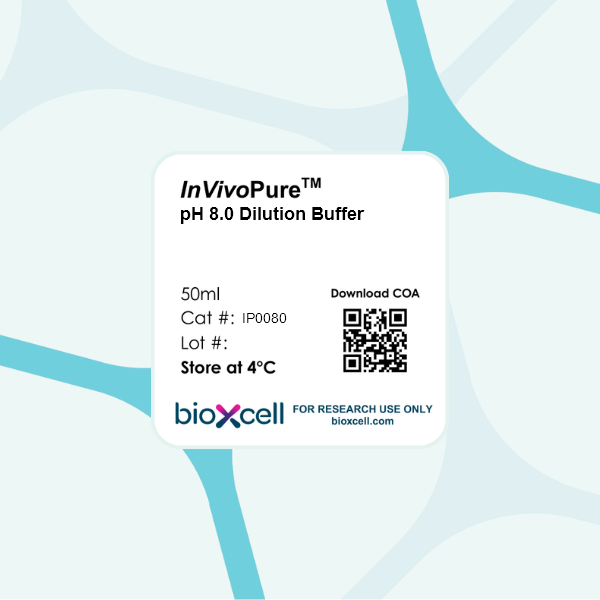InVivoPure pH 8.0 Dilution Buffer
Product Description
Specifications
| Endotoxin |
<0.5 EU/mL (<0.0005EU/μL) Endotoxin level is determined using an LAL gel clotting test |
|---|---|
| Sterility | 0.2 μM filtered |
| Murine Pathogen Tests |
Mouse Norovirus: Negative Mouse Parvovirus: Negative Mouse Minute Virus: Negative Mouse Hepatitis Virus: Negative Reovirus Screen: Negative Lymphocytic Choriomeningitis virus: Negative Lactate Dehydrogenase-Elevating Virus: Negative Mouse Rotavirus: Negative Theiler’s Murine Encephalomyelitis: Negative Ectromelia/Mousepox Virus: Negative Hantavirus: Negative Polyoma Virus: Negative Mouse Adenovirus: Negative Sendai Virus: Negative Mycoplasma Pulmonis: Negative Pneumonia Virus of Mice: Negative Mouse Cytomegalovirus: Negative K Virus: Negative |
| Toxicity Test Results | Nontoxic and nonantigenic in animal models |
| Concentration | 1X |
| Volume | 50 ml |
| Composition |
35 mM Na2HPO4 1.7 mM NaH2PO4 136 mM NaCl This buffer does not contain calcium, magnesium, phenol red, or preservatives such as azide. Keep contents sterile. Open only in a biological safety cabinet. |
| Storage | 4°C |
Product Citations
-
-
Immunology and Microbiology
RGS2 is an innate immune checkpoint for suppressing Gαq-mediated IFNγ generation and lung injury.
In iScience on 21 February 2025 by Joshi, J. C., Joshi, B., et al.
PubMed
Interferon gamma (IFNγ), a type II interferon, augments tissue inflammation following infections, leading to lethal acute lung injury (ALI), yet the mechanisms controlling IFNγ generation in the lungs remain elusive. Here, we identified regulator of G protein signaling 2 (RGS2) as a gatekeeper of the lung's IFNγ levels during infections. Deletion of RGS2 sustained an increase in IFNγ levels in macrophages, leading to unresolvable inflammatory lung injury. This response was not seen in RGS2 null chimeric mice receiving wild-type (WT) bone marrow or the RGS2 gene in alveolar macrophages (AMs) or IFNγ-blocking antibody. RGS2 functioned by suppressing Gαq-mediated IFNγ generation and AM inflammatory signaling. Thus, the inhibition of Gαq blocked IFNγ generation in AMs and rewired AM transcriptomes from an inflammatory to a reparative phenotype in RGS2 null mice, pointing to the RGS2-Gαq axis as a potential target for suppressing inflammatory injury.
-
-
-
Genetics
IFN-γ blockade after genetic inhibition of PD-1 aggravates skeletal muscle damage and impairs skeletal muscle regeneration.
In Cell Mol Biol Lett on 4 April 2023 by Zhuang, S., Russell, A., et al.
PubMed
Innate immune responses play essential roles in skeletal muscle recovery after injury. Programmed cell death protein 1 (PD-1) contributes to skeletal muscle regeneration by promoting macrophage proinflammatory to anti-inflammatory phenotype transition. Interferon (IFN)-γ induces proinflammatory macrophages that appear to hinder myogenesis in vitro. Therefore, we tested the hypothesis that blocking IFN-γ in PD-1 knockout mice may dampen inflammation and promote skeletal muscle regeneration via regulating the macrophage phenotype and neutrophils.
-

